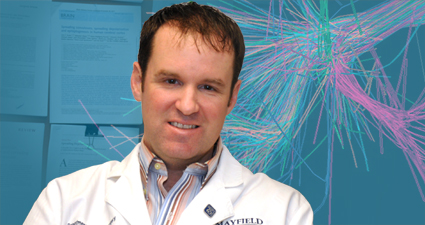
Jed Hartings, PhD, Associate Professor of Neurosurgery at the UC College of Medicine and an expert in spreading depolarizations. Photo by Cindy Starr / Mayfield Clinic.
During the next seven years, 38 institutions from around the world hope to answer a basic but nagging question: how best to treat people who have suffered a brain injury caused by an accident, fall or violence. Jed Hartings, PhD, Associate Professor in the Department of Neurosurgery at the University of Cincinnati, will help find the answer.
Dr. Hartings, who is part of the UC Neuroscience Institute, one of four institutes of the UC College of Medicine and UC Health, will design the data collection methods for a portion of the observational study of 5,000 patients at more than 60 European hospitals who have suffered mild, moderate or traumatic brain injury, or TBI. Dr. Hartings is also charged with assessing and scoring data.
The 30-million-euro study, the Collaborative European NeuroTrauma Effectiveness Research, or CENTER-TBI, is funded by the European Union’s Seventh Framework Programme for Research and Development, part of a global collaboration established by the European Commission, the National Institutes of Health and the Canadian Institute of Health Research. Coordinating centers are the University Hospital Antwerp (Belgium) and the University of Cambridge (England). Only three U.S. institutions will participate: UC, the University of Florida and the University of California, San Francisco. A news conference announcing the study takes place in Antwerp today.
“The overall objective of the grant is to document the variation in practice in treating injuries in order to determine which treatments are most effective,” Dr. Hartings says. “It is a comparative effectiveness study, as opposed to a randomized clinical trial of a specific treatment. These natural variants occur in practice in the area of TBI because we do not yet have adequate evidence that one method of treating a patient is more effective than another. More evidence-based guidelines need to be developed.”
Each year one out of every 200 Europeans and Americans sustains some form of traumatic brain injury, according to the European Commission. The Centers for Disease Control reports that at least 1.7 million traumatic brain injuries occur in the United States each year and that TBI contributes to 30.5 percent of all injury-related deaths.
Despite many advances in medical care, the outcome for a patient with TBI has not changed much over the past 20 years. “We can do much, but not enough,” says Dr. Andrew Maas, Professor and Chairman of Neurosurgery at University Hospital Antwerp. “This is difficult to accept for relatives of the often young patients.”
The magnitude of the study has the global TBI community abuzz, Dr. Hartings says.
“Historically, these large, observational databases have had the biggest impact on improving guidelines for care, in determining what’s effective and what’s not. They tend to have a large impact on the field. What’s exciting about CENTER-TBI is that it will incorporate study of the newest methods for patient monitoring and assessment. That includes imaging studies, biomarkers and the monitoring of spreading depolarizations.”
Dr. Hartings was tapped for the CENTER-TBI study because he is at the forefront of research on spreading depolarizations and is a founding member of the international organization COSBID (Co-Operative Study on Brain Injury Depolarizations). Spreading depolarizations are a pathologic brain activity and complication of traumatic brain injury and stroke. These electrical disturbances spread through an injured brain like tsunamis, and Dr. Hartings has helped show that they lead to worse outcomes in patients.
“Our role in COSBID, in collaboration with other groups in Europe, is to collect neuro-monitoring data that will enable us to assess the relative role of different secondary insults that occur in the intensive care unit – including hypotension, elevated intracranial pressure (ICP) and spreading depolarizations,” he says. “How can we use these factors, in combination, to assess a patient’s status, or outcome risk, or to guide treatment?
“We want to come up with better classification systems to stratify patients in terms of risk for good or poor outcome. For decades we have used the Glasgow Coma Scale, an assessment of the level of consciousness, to determine whether patients have mild, moderate or severe head injury.
“To improve on this limited classification system, we will collect blood samples to assess potential protein biomarkers that might provide us with a more intelligent way of stratifying patients. This would be useful, for instance, in the design of clinical trials that target sub-populations of patients who might benefit from one treatment or another.”
The protein biomarkers being sought would include breakdown products from injured or dying brain cells. This approach will be combined with new approaches in neuroimaging and continuous patient monitoring.
Although the role of Dr. Hartings and his team is modest in the scope of the entire effort, he says the honor of participating cannot be minimized.
“It’s extremely important for results from our smaller research studies to be validated in the context of a massive international effort like CENTER-TBI,” Dr. Hartings says. “That’s the value of the study. It brings all the stake-holders in TBI research into the same arena.”
– Cindy Starr


